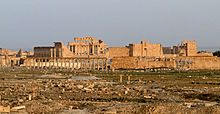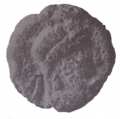Palmyra facts for kids
Quick facts for kids Site of Palmyra * |
|
|---|---|

Ruins of a Roman temple in the middle of Palmyra
|
|
| Country | |
| Type | Cultural |
| Criteria | i, ii, iv |
| Reference | 23 |
| Region ** | Arab States |
| Coordinates | 34°33′36″N 38°16′2″E / 34.56000°N 38.26722°E |
| Inscription history | |
| Inscription | 1980 (4th Session) |
|
|
Palmyra was an amazing ancient city in central Syria. It was like a big rest stop in the desert for travelers. People would stop there when crossing the Syrian Desert. This important city was founded thousands of years ago. It became a World Heritage Site in 1980, recognized by UNESCO.
Contents
What Was Palmyra?
Palmyra was an ancient Arab city. It was built in an oasis, which is a green, fertile spot in a desert. This oasis was about 215 kilometers (134 miles) northeast of Damascus. It was also about 180 kilometers (112 miles) southwest of the Euphrates River.
For a very long time, Palmyra was a key place for travelers. It offered a safe stop for people crossing the vast Syrian Desert. The city was first settled around 2000 BC. It was finally abandoned around 1929.
The Name of Palmyra
The local name for the city was Tadmur. This name comes from the Semitic family of languages. In Aramaic, Tadmur means "a city that cannot be defeated." This shows how strong and important the city was. The earliest mentions of Tadmur are found on ancient tablets from Babylonia. Even today, the city is still called Tadmur in Arabic.
Life in Ancient Palmyra
The people of Palmyra worshipped many different gods and goddesses. These gods came from places like Mesopotamia, Syria, Arabia, and Greece. They built many beautiful temples for their gods. They also created large monuments. These monuments often contained funerary art, which was art made for the dead.
Palmyrans first spoke Aramaic. Later, they started speaking Greek. The area where Palmyra was located eventually became part of the powerful Roman Empire.
Palmyra's Powerful Rulers
Between the years 260 and 273 AD, Palmyra became very powerful. A ruler named Odaenathus and his wife, Zenobia, made Palmyra the capital of their own empire. This was called the Palmyrene Empire. This time was part of a bigger period of trouble for the Roman Empire. It is known as the Crisis of the Third Century.
Palmyra's Later Years
After the time of Odaenathus and Zenobia, Palmyra became less important. By the 16th century, its power had greatly faded. The city was completely abandoned by 1929. This happened during the time of the Ottoman Empire. Today, there is a new town with the same name. It is located just south of the ancient ruins.
Images for kids
See also
 In Spanish: Palmira para niños
In Spanish: Palmira para niños






















